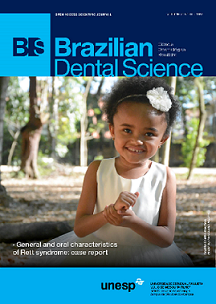Retentive force comparison between esthetic and metal clasps for removable partial denture
DOI:
https://doi.org/10.14295/bds.2017.v20i3.1431Abstract
Objective: This study aimed to evaluate the retention of acetate resin clasp as when compared to metal clasp. Material and methods: For this purpose, we constructed 10 conventional Co-Cr metal clasps (Ackers) and 20 acetate resin clasps. The acetate resin clasps had the opposition, support and retaining arms made of Co-Cr. Of the 20 esthetic clasps, 10 had the thickness of the retention arm decreased to make it more esthetic. The initial retentive force of the specimens was tested in a universal testing machine through tensile test. After that, the specimens were subjected to 7,000 cycles, each one, in an adapted machine, immersed into artificial saliva, for 36 months of simulated clinical use of a removable partial denture. Data were tabulated for statistical analysis of the retention effectiveness. Results: After cycling, 3-mm-thick and 2-mm-thick acetate resin clasps lost more retention than metal clasps. The material type (p=0.0000) and cycling (p=0.0039) showed a significant effect, but the material/cycling interaction (p=0.1436) did not. Conclusions: Therefore, esthetic clasps presented retention force lower than that of metal clasps. Notwithstanding, the esthetic clasps can be used in clinical cases requiring minimum retention.
Keywords
Removable partial denture; Esthetic clasp; Metal clasp.
Downloads
Downloads
Additional Files
Published
How to Cite
Issue
Section
License
Brazilian Dental Science uses the Creative Commons (CC-BY 4.0) license, thus preserving the integrity of articles in an open access environment. The journal allows the author to retain publishing rights without restrictions.
=================




























